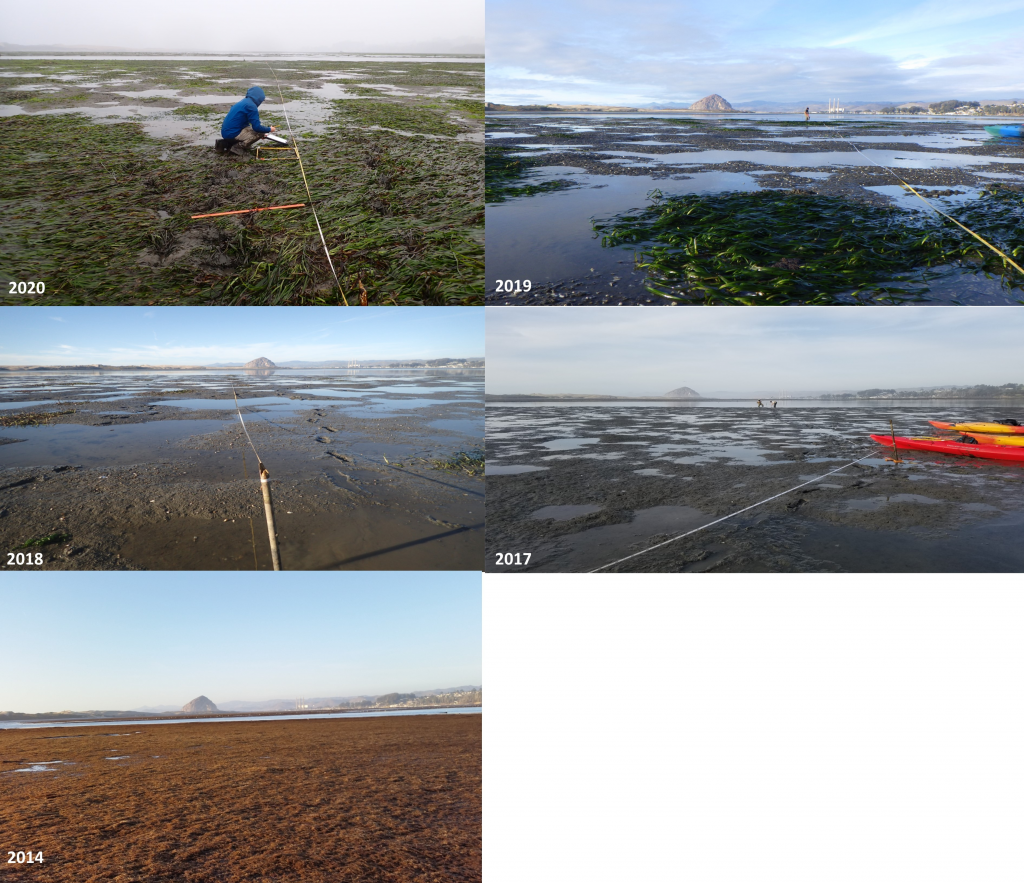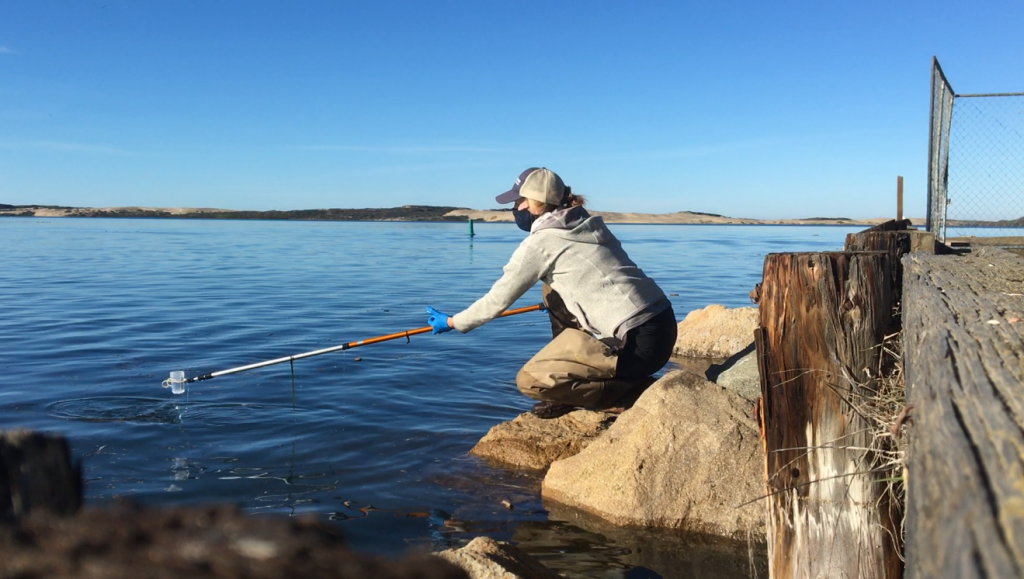The Morro Bay National Estuary Program’s fieldwork has been deemed an essential service by the County of San Luis Obispo. Due to COVID-19 safety precautions, we are not working with volunteers at this time and our field staff are following updated monitoring protocols. We look forward to working with volunteers and other community members again as soon as it is safe for us to do so. Thank you, readers, for staying engaged and supporting the Estuary Program’s work during this difficult time.
Eelgrass Monitoring
Anyone who has spent time on the bay this month may have noticed quite a few very low tide days, like the negative tides between -0.94 and -1.66 feet, as well as a few very high tide days, including the King Tides, between 6.53 and 6.89 feet in height.
These negative tide windows create a great opportunity to monitor intertidal eelgrass, as it is most exposed during these times. Our monitoring team took full advantage of these lower-than-usual December tides to conduct a multi-day eelgrass monitoring effort, to survey eelgrass permanent transects. Many of these sites have been monitored since 2005 to assess eelgrass presence.

Data and photos from these monitoring sites can provide site-specific visuals of eelgrass decline or eelgrass recovery. Our monitoring team has found significantly more eelgrass this year than in previous years, since the decline began over a decade ago.
The time series of images above illustrates changes in eelgrass coverage and extent from a site near Pasadena Point in Los Osos from 2014 to 2020. The bottom photo from 2014 shows nearly no eelgrass, but extensive coverage of gracilaria, a type of red algae. The site was monitored again in 2017 and 2018, and only a bare mudflat remained. Then, during 2019, new patches of eelgrass began to form. We saw these small patches expand and grow during 2020.
Data collected during this year’s monitoring will be available in the 2020 Eelgrass Report, which is expected to be released in mid-2021. Reports from previous years can be found in our online library, under Eelgrass Monitoring Reports.
Updates on the Volunteer Monitoring Program
Given the continued concerns around COVID-19, the Volunteer Monitoring Program is unfortunately still on hold at this point.
Over the last few months, our team has been working diligently to adjust protocols to prepare for the return of volunteers. Our policies allow for volunteer support only when our county is in the red tier or better, as designated by the State of California. Our fingers are crossed that we’ll be able to have our volunteers return during the new year.
Despite not having our typical volunteer opportunities available at this time, we encourage any avid bay kayakers and paddlers to check out our new Eelgrass Tracker effort, where boaters who are already on the bay can help us to track the location and density of eelgrass. Equipped with your own camera and GPS-enabled device (like a smartphone or handheld GPS), you can help us identify the presence or absence of eelgrass while paddling the bay. A win-win!
Monitoring Staff Out and About
With permission from the County’s Emergency Operations Center, the Estuary Program has conducted limited water quality monitoring and bay bacteria sampling throughout much of the pandemic. Many tasks have had to be adjusted to fit COVID-19 restrictions.

Without the support of our typical volunteer base, tasks previously conducted by a team of two volunteers have now been delegated to a single staff member. While there can be solace found in solo-fieldwork, we are all looking forward to working alongside one another in the future!
Help protect and restore the Morro Bay estuary
- Donate to the Estuary Program and support our work in the field, the lab, and beyond.
The Estuary Program is a 501(c)3 nonprofit. We depend on funding from grants and generous donors to continue our work. - Support us by purchasing estuary-themed gear from ESTERO. This locally owned and operated company donates 20% of proceeds from its Estuary clothing line and 100% of Estuary decal proceeds to the Estuary Program. Thank you, ESTERO!
- Purchase items from the the Estuary Program’s store on Zazzle. Zazzle prints and ships your items, and the Estuary Program receives 10% of the proceeds. Choose from mugs, hats, t-shirts, and even fanny packs (they’re back!) with our fun Estuary Octopus design, our classic Estuary Program logo, or our Mutts for the Bay logo.
Thank you for your support!